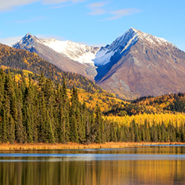Wrangell-St. Elias National Park
Scott McMurren
Alaska Travelgram | [email protected]
There are many roads to Wrangell-St. Elias National Park. What I mean is there are many reasons which draw travelers to the nation’s largest national park.
Back in the 1890s, explorers looking for gold happened upon some rich copper veins. The boom that resulted, bankrolled by East Coast industrialists, changed the face of the land forever. The town of Kennicott, in the heart of the park, became the site of the world’s richest copper mine in less than five years. When the mining company pulled up stakes in the 1930s, they left behind an “instant” ghost town. Visitors can walk back in time, exploring where the miners lived and worked.
Today, travelers come to see the mix of history and adventure in the park. From the lobby of the Copper River Princess, you can see a trio of the huge peaks in the park: Mt. Sanford, Mt. Drum and 16,233-foot Mt. Wrangell. It’s a spectacular vista from the lodge, overlooking the Klutina River as it runs into the Copper River. Big mountains. Big rivers. Big country.
The best way to visit the town of McCarthy and the adjoining ghost town of Kennicott is to fly with Wrangell Mountain Air. The husband-wife team, Kelly and Natalie Bay, oversee a fleet of single-engine aircraft that makes two scheduled flights per day between Chitina Airport and McCarthy. Chitina is on the shores of the Copper River at the end of the paved section of the McCarthy Road, also known as the Edgarton Highway. Although the road is state-maintained, your rental car contract specifically excludes the road from its roadside assistance agreement. That means if your car breaks down, you’ll be looking at an expensive tow bill! I suppose that’s what happens when you build a road on top of an old railroad bed!
The flight from Chitina to McCarthy is a fabulous ride. After taking off over the Copper River, your pilot probably will leave the road behind and start climbing toward Fourth of July Pass. Along the way you’ll likely see some interesting “Rock Glaciers” and perhaps some mountain goats grazing on the mountainsides. But the highlight of the flight comes when your pilot emerges on the far side of the pass. Below you is a sea of ice. Tumbling off of the south face of Mt. Wrangell is a glacial ice fall–tumbling from 11,000 feet to form Kennicott Glacier. Altogether, three glaciers converge in the valley below. Your pilot will talk about how the huge piles of rock are glacial sediment…not copper tailings from the mine. You should be able to make out some tiny red specks on the far side of the valley up on the mountain. As you get closer, you can see they are the remains of the bunkhouses where the miners lived for up to a year at a time. Missing are the miles-long cable which hauled the ore from the mine to the central processing plant in town. But you’ll have the opportunity to learn more about the mines once you’re on the ground.
 A National Park With History
A National Park With History
The best way to visit the town of McCarthy and the adjoining ghost town of Kennicott is to fly with Wrangell Mountain Air. The husband-wife team, Kelly and Natalie Bay, oversee a fleet of single-engine aircraft that makes two scheduled flights per day between Chitina Airport and McCarthy.
On the ground in McCarthy, you can choose from several cool activities. Don’t miss the museum in town, which documents the development of the Kennicott Mine and has a trove of great photos, maps and plottings from around the area. You’ll learn about how the town of Kennicott had electricity, a movie theater, tennis courts and lots of high-end amenities. You’ll also learn about the conditions where the miners worked, how much they earned and where they came from to mine the copper.
Make plans to visit the town of Kennicott, located about five miles from McCarthy. Stop in for lunch at the Kennicott Glacier Lodge. The lodge sits on the site where the mine manager’s office used to be, as well as apartments for visiting VIPs. Across from the lodge, the folks at St. Elias Alpine Guides can arrange for a tour of the main processing areas in the mine building. This 14-story structure took the ore at the top of the building. Then, the ore was sent through a variety of crushers and shakers, emerging at the other end in 55-pound bags to be loaded onto rail cars for the journey down the Copper River Valley to Cordova. There, the ore was shipped to refineries in the Seattle area.
St. Elias Alpine Guides also can arrange a guided glacier hike. This is great fun and almost anyone can do it! Your guides are safety conscious (EMT trained) and know their way around the country. Don’t be surprised if you see a bear on your way up to the glacier! Your guides will go through bear safety tips as well as tips for walking on the glaciers. Everybody gets a pair of crampons to strap on your boots. Then, you hike a little more than a mile up to the face of the glacier. Depending on what you want to do, your guide will show off some of the ice caves, some “moulans” which are super-blue pools of water, some crevasses and other features of the glaciers. Other options include ice-climbing classes and multi-day hikes on the glaciers.
If you’ve had the chance to explore the glacier, seen the mine and flown over the area in a plane, you can hike around the townsite and up into the hills to one of the old mine bunkhouses, including the Bonanza Mine. It’s an all-day hike, but the bird’s-eye view is spectacular.
Don’t miss out on a visit to Wrangell-St. Elias National Park. You’ll discover why this park is one of Alaska’s best-kept secrets!